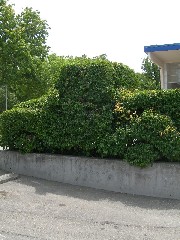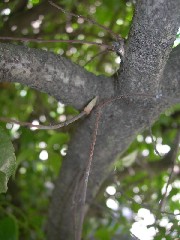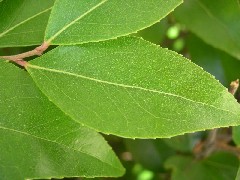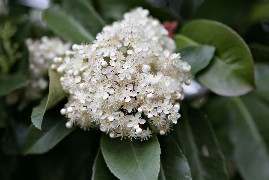Photinia
Photinia sp.Rosaceae
podcast script
| http://www.answers.com/topic/photinia-1 |
Classification:
Angiosperm, Dicot, evergreenSize:
Height: 3-35 mWidth: 3-5 m
Identifying Features:
Naturally bushlike in shape but easily pruned into the shape of a tree, a hedge, or other objects. Leaves turn from green to red as they mature. Photinia plants have an alternate leaf pattern with oval shaped leaves 3 to 15 cm in length. Flowers grow in clumps which contain small white blossoms with five petals each.Location/Habitat:
There are between 40 and 60 different species of photinia. From these, only one, photinia arbutifolia is native to North America. The plant at DHS is likely either photinia glabra (Japanese Photinia), photinia serrulata (Chinese Photinia), or photinia x fraseri (Red Tip Photinia). Although native to Asia, each has been introduced to the U.S. as a garden plant and all three are grown in California.Flower/Fruit/Reproduction:
Small round red or black berries.Water/Sun Requirements:
Photinia grows best in full sun and is drought resistant.Special Adaptations:
Thick waxy cutin inhibits too much water transpiration and allows for a high drought tolerance.Other Info:
Fast growth rate.Reference Sources/Links:
Answers.com. http://www.answers.com/topic/photinia-1IPGRI Fruits of America Ethnobotanical Inventory. www.ciat.org
Photinia.info. http://www.photinia.info/
US Forest Service and Dept. of Agriculture Website. http://hort/trees.pdf
Created by Erin C. 2007



